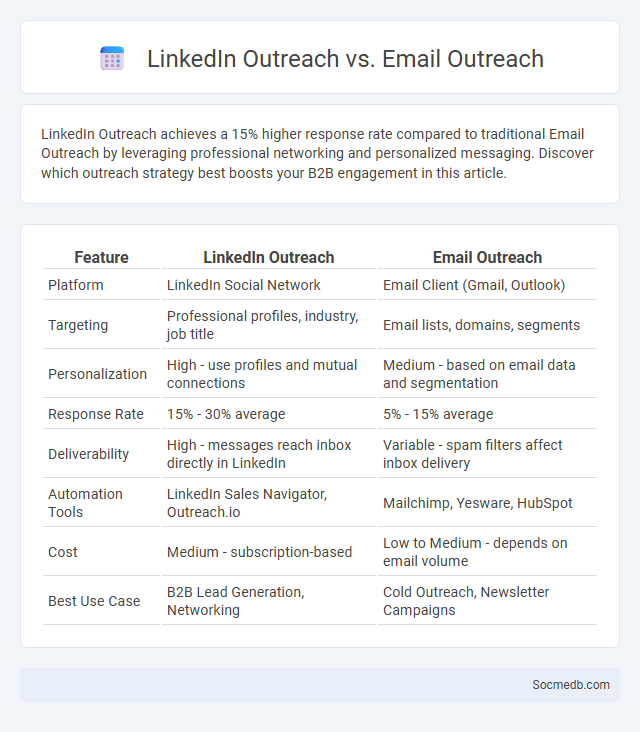
Photo illustration: LinkedIn Outreach vs Email Outreach
LinkedIn Outreach achieves a 15% higher response rate compared to traditional Email Outreach by leveraging professional networking and personalized messaging. Discover which outreach strategy best boosts your B2B engagement in this article.
Table of Comparison
| Feature | LinkedIn Outreach | Email Outreach |
|---|---|---|
| Platform | LinkedIn Social Network | Email Client (Gmail, Outlook) |
| Targeting | Professional profiles, industry, job title | Email lists, domains, segments |
| Personalization | High - use profiles and mutual connections | Medium - based on email data and segmentation |
| Response Rate | 15% - 30% average | 5% - 15% average |
| Deliverability | High - messages reach inbox directly in LinkedIn | Variable - spam filters affect inbox delivery |
| Automation Tools | LinkedIn Sales Navigator, Outreach.io | Mailchimp, Yesware, HubSpot |
| Cost | Medium - subscription-based | Low to Medium - depends on email volume |
| Best Use Case | B2B Lead Generation, Networking | Cold Outreach, Newsletter Campaigns |
Introduction to Modern B2B Outreach
Modern B2B outreach leverages social media platforms such as LinkedIn, Twitter, and Facebook to connect with decision-makers, generate leads, and build brand authority. Utilizing targeted content marketing, personalized messaging, and data-driven analytics enhances engagement and conversion rates in business-to-business interactions. Effective social media strategies integrate CRM tools and automation to streamline communication and track prospect behavior for optimized outreach campaigns.
Understanding LinkedIn Outreach
LinkedIn outreach is a strategic method to connect with professionals and potential clients by leveraging personalized messages and targeted networking. Optimizing your LinkedIn profile and understanding the platform's algorithm can significantly enhance your visibility and engagement rates. You should focus on building authentic relationships through relevant content and thoughtful communication to maximize the impact of your outreach efforts.
Exploring Email Outreach Techniques
Email outreach techniques enhance your social media strategy by targeting specific audiences with personalized content that drives engagement and conversions. Segmenting your email list based on user behavior and preferences boosts open rates and encourages meaningful interactions. Crafting compelling subject lines and clear calls-to-action ensures your message cuts through the noise and prompts recipients to connect with your social media channels.
Defining Lead Generation Strategies
Effective lead generation strategies on social media leverage targeted content, precise audience segmentation, and engagement-driven campaigns to attract potential customers. By analyzing platform-specific data and user behavior, you can optimize your messaging to convert followers into qualified leads efficiently. Utilizing tools such as lead magnets, retargeting ads, and interactive posts enhances the likelihood of capturing high-quality leads that align with your business goals.
LinkedIn Outreach vs Email Outreach: Key Differences
LinkedIn outreach leverages personalized profile insights and professional networking features to engage prospects, enhancing trust and response rates. Email outreach allows for scalable, automated campaigns with customizable messaging but faces higher risks of being filtered as spam. Effective strategies often combine LinkedIn's relationship-building capabilities with targeted email follow-ups to maximize lead generation and conversion.
Pros and Cons of LinkedIn Outreach
LinkedIn outreach enhances professional networking by enabling targeted connections with industry leaders, potential clients, and collaborators, boosting career growth and business opportunities efficiently. It offers precise audience segmentation, personalized messaging, and measurable engagement metrics, which improve lead generation and relationship building. However, excessive outreach can lead to message fatigue, reduce response rates, and potentially damage professional reputation if perceived as spam or insincere.
Pros and Cons of Email Outreach
Email outreach offers a direct and personalized approach to engage target audiences, enabling precise segmentation and measurable campaign performance through metrics like open rates and click-through rates. However, it faces challenges such as potential spam filters, lower response rates compared to social media messaging, and the risk of damaging brand reputation if emails are perceived as intrusive or irrelevant. Effective email outreach requires balancing personalization with compliance to regulations like GDPR and CAN-SPAM to maintain trust and maximize conversion rates.
Integrating LinkedIn and Email for Enhanced Lead Generation
Integrating LinkedIn with email campaigns significantly boosts lead generation by leveraging LinkedIn's advanced targeting tools to identify high-quality prospects and using personalized email outreach to nurture these leads effectively. Combining LinkedIn Sales Navigator insights with automated email sequences increases engagement rates and accelerates conversion by delivering tailored content based on prospect behavior and professional interests. Businesses utilizing this strategy report higher ROI due to more precise targeting and strengthened multichannel communication that drives consistent lead qualification and sales pipeline growth.
Metrics to Measure Outreach Success
Key metrics to measure social media outreach success include engagement rate, which tracks likes, comments, and shares relative to followers, and reach, indicating the total number of unique users who have seen your content. Conversion rate measures how many users complete desired actions, such as signing up for newsletters or making purchases, providing insight into campaign effectiveness. Monitoring follower growth and click-through rate (CTR) on links also helps evaluate audience expansion and content relevance.
Choosing the Right Outreach Approach for Your Business
Choosing the right outreach approach for your business on social media involves identifying your target audience's preferences and behaviors. Tailoring your content to platform-specific features, such as Instagram Stories or LinkedIn articles, enhances engagement and brand visibility. You will maximize your ROI by using data-driven insights to select channels and messaging that resonate with your ideal customers.
 socmedb.com
socmedb.com